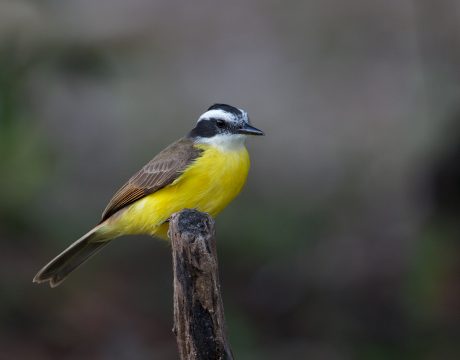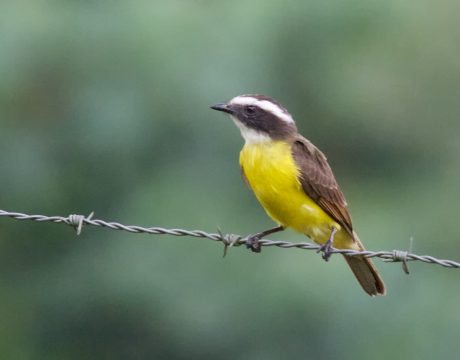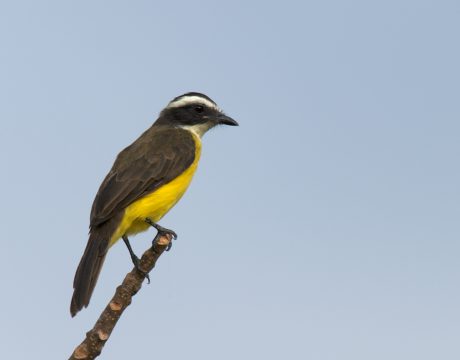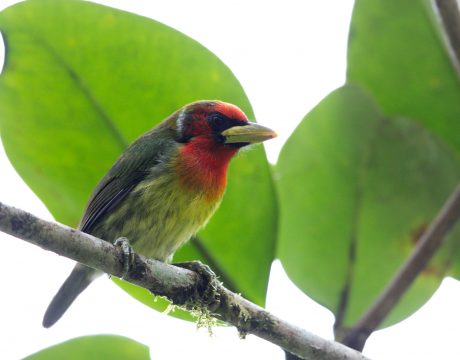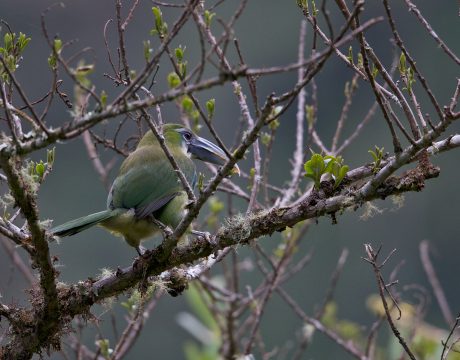Return of Bird of the Week: Hammond’s Flycatcher
Identification of flycatchers can be hard. Really hard. But now that we’re warmed up with all those yellow, black and white flycatchers, let’s look at some reallyhard birds: the infamous Empidonaxgenus, the “Emps.” Because after you’ve done Emps, nothing will seem as hard. In Alaska, at least. the commonest Emp is the Hammond’s Flycatcher. We’ll start there. All Empids are drab. All have pale eye rings and wing bars. Identification depends on subtle differences in voice, size, bill shape, the extent their primary wing feathers project beyond the tail, and tail length. Hammond’s Flycatcher, Empidonax hammondii, is small with a disproportionately large…
Return of Bird of the Week: White-ringed Flycatcher
Oh gawd, WC, another yellow, black and white bug-eating bird? Yep. This bird specializes in forest edges, hunting from perches a bit higher than other Tyrant flycatchers. This bird’s call is different, too, but unhappily for birders, Tyrant flycatchers don’t vocalize all that often. Note that the white ring on the bird’s head – technically, its called a supercilliary – extends all the way around the head, and there is no rufous in the wings. But it’s tough to distinguish this bird from its look-alike cousins. The White-ringed Flycatcher is found from eastern Honduras south to northwest Ecuador. The species’…
Return of Bird of the Week: Lesser Kiskadee
Oh look! It’s yet another yellow, black and white flycatcher! WC warned you: there are a lot of flycatchers, and many of them look a lot alike. This is a Lesser Kiskadee, Philohydor lictor, a smaller cousin to the Great Kiskadee. The Lesser Kiskadee has the same basic coloration as the Rusty-margined Flycatcher and the Social Flycatcher – all three are Tyrant Flycatchers, members of the family Tyrannidae – But in the Lesser the white ring on the head comes all the way around the front. The reddish in the wings and tail is more extensive, and the black mask is…
Return of Bird of the Week: Rusty-margined Flycatcher
Last week we looked at a Social Flycatcher, and WC warned that it could be tough to tell the Myiozetetesflycatchers apart. Meet the Rusty-margined Flycatcher. At first glance, they look identical, but note the slight cinnamon/rufous color along the edge of the wings, and the even fainter yellow-greenish coloration across the back. The black mask is slightly narrower. Those are tough field marks. The Rusty-margined is a close cousin of the Social Flycatcher, both members of the Myiozetetes genus. Rustys are much less common than the Socials, although both species often forage for bugs out in the open. The species is very…
Return of Bird of the Week: Toucanets
There is another family of big-billed birds, although their bills are slightly smaller than Toucans. They are called, appropriately enough, Toucanets. In WC’s experience, these smaller birds are shyer than their bigger cousins, and even more likely to skulk in dense foliage. While Toucanets are reportedly generalists, eating a wide variety of fruits and nuts, every one that WC has seen has been in a Cecropia tree. The Blue-banded Toucanet is found in Bolivia and Peru. The Crimson-rumped Toucanet is a cousin, generally with a more northerly range. WC photographed this bird at the very southern limit of its range, where…
Return of Bird of the Week: Yellow-breasted Toucan
Another handsome, big-billed bird. When WC photographed this bird, it was a Chestnut-mandibled Toucan, but in 2009 the Chestnut-mandibled was combined with – “lumped” – the Yellow-breasted Toucan. The Chestnut-mandibled is now a subspecies. It says something about the taxonomy of Toucans that ornithologists say there are 7 to 15 species, depending on which one you are talking to. The lumped species has a considerable range, from Honduras to western Ecuador. That extensive range is one of the reasons this is a species of least concern, presently not significantly threatened. Yellow-throated Toucan is able to tolerate some human disturbance and forest…
Return of Bird of the Week: Fiery-billed Aricari
By popular demand, we’ll stay with Ramphastidae, the family of long-billed birds that includes last week’s Keel-billed Toucan. Here’s a Fiery-billed Aracari. Unlike the more widely distributed Keel-billed Toucan, the Fiery-billed Aracari has a pretty restricted range, limited to the Pacific slopes of eastern Costa Rica and western Panama. This aracari’s diet is somewhat catholic; while primarily frugivorous (fruit- and nut-eating), it also takes insects, as well as the eggs and young of birds as large as pigeons and woodpeckers. Fiery-billed Aracaris are cavity nesters and cavity roosters. They’ve been observed forcibly evicting woodpeckers from their nesting holes, which they…
The Simple Truth Behind Ballot Initiative No. 1
There is a lot of money being spent to get Alaskans to “Vote No” on Ballot Measure No. 1, with those opponents painting pictures of certain doom for Alaska’s economy. But what those opponents don’t say speaks volumes as to their motivations. Unfortunately, the messaging about what Ballot Measure No. 1 truly does is rather scattered, so let’s bring it all together. First, let’s start with a little history. One of the principal reasons for becoming a state, which was discussed over and over again at the Alaska Constitutional Convention in Fairbanks in November 1955, was the mismanagement of our…







